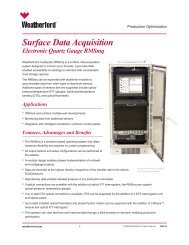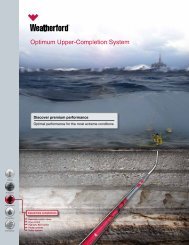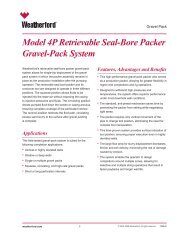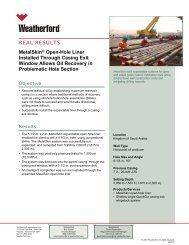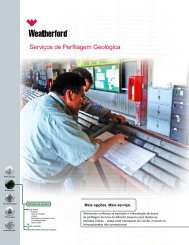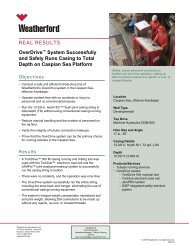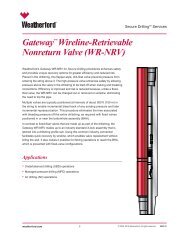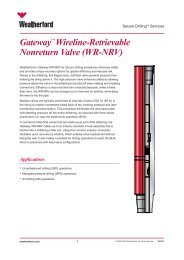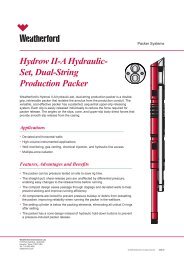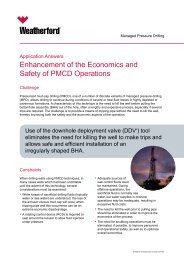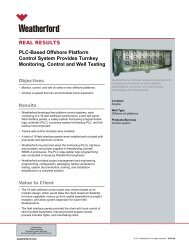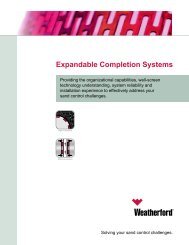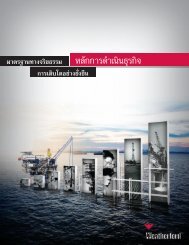Addressing Deepwater Challenges - Weatherford International
Addressing Deepwater Challenges - Weatherford International
Addressing Deepwater Challenges - Weatherford International
You also want an ePaper? Increase the reach of your titles
YUMPU automatically turns print PDFs into web optimized ePapers that Google loves.
alignment device makes running tubing a more expedient<br />
operation. The new OverDrive top-drive casing running and<br />
drilling system leads the next generation of mechanized<br />
tubular running systems, essentially providing all the<br />
functionality of a power tong, elevator, fill-up and circulating<br />
tool, single-joint compensator and torque turn system in one<br />
fully automated package attached to the rig’s top drive.<br />
The end result is a safer, more efficient operation.<br />
Modeling and reserves calculations. <strong>Weatherford</strong><br />
Laboratories’ coring and core-analysis capabilities provide the<br />
finite measurements relative to geology and sedimentology.<br />
Geochemistry and geomechanics analysis further expand<br />
data on formation properties and fluid sensitivities, populating<br />
and sharpening reservoir models to further mitigate risk, more<br />
accurately quantify the size of the field and refine reserves<br />
calculations. “We are the world leader in unconsolidated core<br />
preservation and analysis, a key need in many deepwater<br />
exploration plays,” says Bechtel. “Our rock mechanics<br />
expertise is applied to analyze and predict hole stability for<br />
drilling hazard mitigation technologies. And our geochemical<br />
analysis is critical for clients designing production systems that<br />
maximize flow assurance.”<br />
Q<br />
A<br />
How, specifically, do these<br />
technologies help clients meet<br />
their deepwater challenges<br />
<strong>Weatherford</strong>’s Web site is full of examples of how<br />
these technologies have saved clients significant<br />
amounts of money.<br />
Among the most impressive achievements is a world<br />
record-breaker in the Gulf of Mexico (GoM). In this project<br />
<strong>Weatherford</strong> provided formation evaluation data in an<br />
8 1/2‐inch hole section that was directionally drilled with the<br />
company’s Revolution ® rotary-steerable drilling assembly<br />
to a depth of 29,314 feet (8,935 meters). <strong>Weatherford</strong>’s<br />
LWD system was then used in the 6-inch hole section to<br />
successfully drill to 34,189 feet (10,420 meters), setting a<br />
record for the deepest well ever drilled in the GoM.<br />
The job also set a world record for high-pressure LWD, at<br />
29,976 pounds (199 megapascals). Maximum temperature<br />
was 280°F (138°C). Real-time data transmission rates<br />
exceeded 90 percent, and the well was declared a<br />
discovery, with 600 feet (183 meters) of oil sand in multiple<br />
zones. “Equally important were time and cost savings on<br />
a well with a spread cost of US $500,000 per day and an<br />
estimated additional cost of $1.1 million for round trips of the<br />
drillstring from depths below 25,000 feet [7,620 meters],”<br />
says Timmins.<br />
Reliability is a paramount concern when dealing with<br />
deepwater scenarios. And attaining accurate, real-time data<br />
is key to understanding well performance and reservoir<br />
depletion strategy. <strong>Weatherford</strong> has more than a decade<br />
of experience with optical sensing and intelligent-well<br />
technologies, including 1,136 miles (1,800 kilometers) of<br />
optical fiber and 400 optical sensors installed in wells around<br />
the world. These achievements reflect more than three<br />
million cumulative in-well operating hours for <strong>Weatherford</strong>’s<br />
optical systems and serve as testaments to the systems’<br />
reliability in critical applications.<br />
“A major operator in the GoM recently used our<br />
displaceable DrillShoe II tool to ream a string of 11 3/4-inch<br />
casing through a problematic rubble zone,” says Hayes.<br />
Previous attempts to work the drillstring through this zone<br />
had been unsuccessful.<br />
Clients have used several variants of MPD in the deepwater<br />
fields of Indonesia, GoM and Brazil to enable drilling through<br />
trouble zones that had thwarted attempts with conventional<br />
drilling practices.<br />
“The list of clients using our mechanized tubular running<br />
services continues to grow almost daily. We are the global<br />
leader in the provision of these services, with over 200<br />
installations around the world, the majority of which are in<br />
deep water,” says Hayes.<br />
may 2008 5



